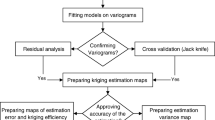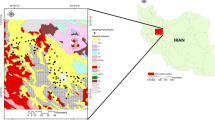Abstract
Modeling groundwater properties is an important tool by means of which water resources management can judge whether these properties are within the safe limits or not. This is usually done regularly and in the aftermath of crises that are expected to reflect negatively on groundwater properties, as occurred in Jordan due to crises in neighboring countries. In this study, specific capacity and salinity of groundwater of B2/A7 aquifer in Amman Zarqa Basin were evaluated to figure out the effect of population increase in this basin as a result of refugee flux from neighboring countries to this heavily populated basin after Gulf crises 1990 and 2003. Both properties were found to exhibit a three-parameter lognormal distribution. The empirically calculated β parameter of this distribution mounted up to 0.39 m3/h/min for specific capacity and 238 ppm for salinity. This parameter is suggested to account for the global changes that took place all over the basin during the entire period of observation and not for local changes at every well or at certain localities in the basin. It can be considered as an exploratory result of data analysis. Formal and implicit evaluation followed this step using structural analysis and construction of experimental semivariograms that represent the spatial variability of both properties. The adopted semivariograms were then used to construct maps to illustrate the spatial variability of the properties under consideration using kriging interpolation techniques. Semivariograms show that specific capacity and salinity values are spatially dependent within 14,529 and 16,309 m, respectively. Specific capacity semivariogram exhibit a nugget effect on a small scale (324 m). This can be attributed to heterogeneity or inadequacies in measurement. Specific capacity and salinity maps show that the major changes exhibit a northwest southeast trend, near As-Samra Wastewater Treatment Plant. The results of this study suggest proper management practices.












Similar content being viewed by others
References
Al Kuisi, M., & Abdel-Fattah, A. (2010). Groundwater vulnerability to selenium in semi-arid environments: Amman Zarqa Basin, Jordan. Environmental Geochemistry and Health, 32(2), 107–128.
Al Kuisi, M., Al-Qinna, M., Margane, A., & Aljazzar, T. (2009). Spatial assessment of salinity and nitrate pollution in Amman Zarqa Basin: a case study. Environmental Earth Science, 59, 117–129. doi:10.1007/s12665-009-0010-z.
Al Kuisi, M., Saffarini, G., Yaseen, N., & Alawi, M. (2012). Potential Occurrence of MTBE and BTEX in Groundwater Resources of Amman–Zarqa Basin, Jordan. Clean – Soil, Air, 40(8), 808–816.
Al Kuisi, M., Mashal, K., Al-Qinna, M., Hamad, A., & Margana, A. (2014). Groundwater vulnerability and hazard mapping in an arid region: case study, Amman-Zarqa Basin (AZB)-Jordan. Journal of Water Resource and Protection, 6, 297–318. doi:10.4236/jwarp.2014.64033.
Al-Abed, N., & Al-Sharif, M. (2008). Hydrological modeling of Zarqa River Basin – Jordan using the hydrological simulation program—FORTRAN (HSPF) Model. Water Resources Management, 22(9), 1203–1220.
Al-Abed, N., Abdulla, F., & Abu Khyarah, A. (2005). GIS-hydrological models for managing water resources in the Zarqa River Basin. Environmental Geology, 47, 405–411.
Al-Mahamid, J. (2005). Integration of water resources of the upper aquifer in Amman Zarqa Basin based on mathematical modeling and GIS, Jordan. Freiberg Online Geology, 12, 223.
Al-Tarazi, E., El-Naqa, A., El-Waheidi, M., & Abu-Rajab, J. (2006). Electrical geophysical and hydrological investigations of groundwater aquifers in Ruseifa municipal landfill, Jordan. Environmental Geology, 50, 1095–1103.
Aristizabal, RJ. (2012) Estimating the parameters of the three-parameter lognormal distribution. FIU Electronic Theses and Dissertations. Miami: Paper, p. 575.
Bajjali, W. (1997). Using ArcView to determine the origin of groundwater salinity in Dhuleil, Halabat, and Samra area of Jordan. San Diego, Ca, USA: ESRI User Conference.
BGR, MWI (2001). Contributions to the hydrology of northern Jordan. Federal Institute for Geosciences and Natural Resources (BGR) and Ministry of Water and Irrigation (MWI). Jordan: Amman.
Charbeneau, R. (1978). Comparison of the two-three-parameter log normal distributions used in stream flow synthesis. Water Resources Research, 14(1), 149–156.
Clark, I. (1979). Practical geostatistics (p. 129). London: Applied Science Publishers Ltd.
David, M (1977). Geostatistical ore reserve estimation. Amsterdam: Elsevier, p. 364.
Douaik, A. van Meirvenne M, and Tóth T (2011) Statistical Methods for the Analysis of Soil Spatial and Temporal Variability, Principles, Application and Assessment in Soil Science, Dr. Burcu E. Ozkaraova Gungor (Ed.), ISBN: 978-953-307-740-6, InTech, Available from: http://www.intechopen.com/books/Principles-application-and-assessment-in-soil-science/statistical-methods-for-the-analysis-of-soil-spatial-and-temporal-variability
El-Naqa, A., Hammouri, N., & Kuisi, M. (2006). GIS-based evaluation of groundwater vulnerability in the Russeifa Area, Jordan. Rev Mex Cienci Geol, 23(003), 277–287.
Fitch, JB (2001) Curtailment of groundwater use for irrigated agriculture in the Amman–Zarqa Basin. Uplands: an economic analysis. For ARD-USAID, 38p + appendixes, USAID, Amman
Gajem, Y., Warrick, A., & Myers, D. (1981). Spatial dependence of physical properties of a typic Torrifluent Soil. Soil Science Society of America Journal, 45, 709–715.
Goode DJ, Senior LA, Subah A, and Jaber A (2013): Groundwater-level trends and forecasts, and salinity trends, in the Azraq, Dead Sea, Hammad, Jordan Side Valleys, Yarmouk, and Zarqa groundwater basins, Jordan U.S. Geological Survey Open-File Report 2013–1061, 80 p, available online at http://pubs.usgs.gov/of/2013/1061/
Gundogdu, K., & Guney, I. (2007). Spatial analysis of groundwater levels using universal kriging. Journal of Earth System Science, 116(1), 49–55.
Gupta, N., Rudra, R., & Parkin, G. (2006). Analysis of spatial variability of hydraulic conductivity at field scale. Canadian Biosystems Engineering, 48(1), 55–65.
Humphrey, H. (1983). Monitoring and evaluation of the Amman–Zarqa aquifer. Amman Water and Sewage Authority report, 1, 156.
Isaaks, E, Srivastava, R (1990) An introduction to applied geostatistics. New York: Oxford University Press, p. 560.
Koutsoyiannis, D. (2008). Probability and statistics for geophysical processes. Athens: National Technical University of Athens.
Krige, D. (1978). Lognormal-de Wijsian geostatistics for Ore Evaluation. Johannesburg: Institute of mining and metallurgy.
Limpert, E., Stahel, V., & Abbt, M. (2001). Log-normal distributions across the sciences: keys and clues. Bioscience, 51(5), 341–352.
MWI (2000). Ministry of water and irrigation open files. Jordan: Amman.
MWI (2007). Ministry of water and irrigation open files. Jordan: Amman.
Rendu, J. M. (1978). An introduction to geostatistical methods of mineral evaluation. Johannesburg: Institute of mining and metallurgy.
Robertson, G. (2000). Geostatistics for the environmental sciences. Plainwell, Michigan: Gamma Design software, Version 5.
Salameh, E., & Bannayan, H. (1993). Water resources of Jordan: future and future potentials (p. 183). Amman: Friedrich Ebert Stiftung.
Sangal, B., & Biswas, A. (1970). The 3-parameter lognormal distribution and its applications in hydrology. Water Resources Research, 6(2), 505–515.
Stedinger. (1980). Fitting log normal distributions to hydrologic data. Water Resources Research, 16(3), 481–490.
Ta’any, R, Tahboub, A, and Saffarini, G (2009). Geostatistical analysis of spatiotemporal variability of groundwater level fluctuations in Amman–Zarqa basin, Jordan: a case study. Environ Geol. 57: 525–535, DOI 10.1007/s00254-008-1322-0, Springer-Verlag, Germany.
Acknowledgments
The authors would like to express their sincere appreciation and gratitude to the Ministry of Water and Irrigation and namely to Eng. Mohammad Momani for the kind permission to use the data bank files. Thanks are also due to colleague Dr. Susan White, La Trobe University, Australia and the journal’s reviewers for improving the original manuscript.
Author information
Authors and Affiliations
Corresponding author
Appendix
Appendix
Rights and permissions
About this article
Cite this article
Shaqour, F., Taany, R., Rimawi, O. et al. Quantifying specific capacity and salinity variability in Amman Zarqa Basin, Central Jordan, using empirical statistical and geostatistical techniques. Environ Monit Assess 188, 46 (2016). https://doi.org/10.1007/s10661-015-5051-z
Received:
Accepted:
Published:
DOI: https://doi.org/10.1007/s10661-015-5051-z




